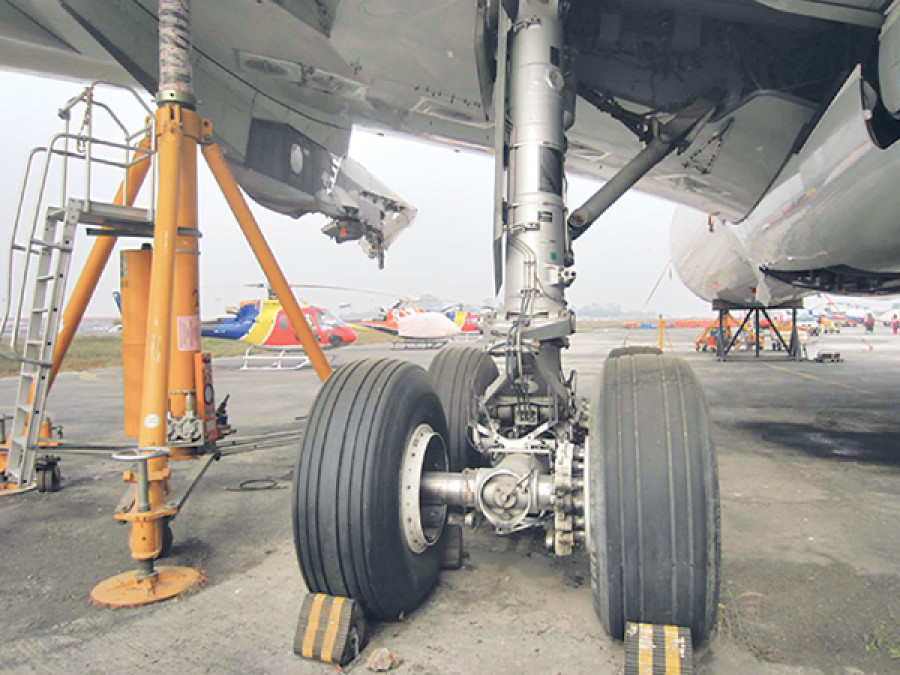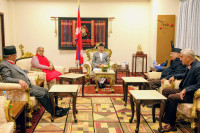Opinion
Blind fixation
The Turkish Airlines fiasco has demonstrated the accuracy of satellite-based procedure
It has now been confirmed that the Turkish Airlines’ flight TK726 ran aground at the Tribhuvan International Airport (TIA) on March 3, primarily due to the crew’s intent to land in a visually adverse condition. The missed approach, or the ‘go around’ procedure as laid in the satellite-based system, is much simpler than the VOR/DME approach traditionally used to land in Kathmandu.Coincidentally, I was monitoring the missed approach in progress on Flightradar24, a live flight tracker website, on that fateful day. There are still not many takers for this approach and even fewer among them have reasons to give landing a miss.
Following the first unsuccessful bid, the question was: would it land uneventfully or divert? It became less exciting after the flight ‘appeared’ to have landed normally. As with most accidents, the initial information was fuzzy and the aircraft was assumed to have slipped out of the runway. But this was unlikely in the absence of mud, snow or rain. The aircraft (TC-JOC) was not even a year old and it could have possibly flown for 20 years or so as a passenger liner and possibly as a freighter thereafter. However, it crash-landed after flouting all safety norms on a foggy morning in Kathmandu.
At first, it was treated as an ‘incident’ (indicative of minor occurrences) more so as there were no fatalities. Any occurrence that results in fatalities or serious injuries or causes serious damage to an aircraft or other property is termed as an accident. It was nothing less than a major accident but the worry was if the aircraft could be salvaged or not. Two of its engines were long removed and flown away. Yet, even after ten months after the accident, the frame has been accorded a permanent spot at the TIA precinct even as flights are often stacked up in the air due to lack of parking space.
A similar debacle
TK726 might very well have been a horrendous landing disaster in Kathmandu. But the relief brought by the fact that it did not happen was short lived as all international flights at the TIA were cancelled for four days resulting in utter chaos.
The A330 was stuck resulting in operational safety hazard because of runway proximity. It is understandable that the lifting air bags took time to arrive as these are spread globally and available only at specified airports. The major predicament was largely a result of lack of basic equipment at the TIA required for moving a wide body aircraft. Since the incident, Kathmandu has earned a notoriety of being a city with an airport that lacks the most basic removal equipment. Besides that, an estimated 50,000 passengers faced immense hardship has a wider consequence for the tourism industry and the country as a whole.
The Air France accident in 2005 in Toronto comes closest to this fiasco as far as breaking of frontal landing gear and zero fatalities are concerned. The A340 landed during an extreme condition with severe wind, heavy rains and localised thunderstorm in contrast to foggy but very calm Kathmandu. Even though the aircraft was gutted by fire, evacuation was efficiently carried out with theoretical precision. It overshot the runway by about 300 metres, crashed into a creek and caught fire. It possibly overshot because the aircraft missed the touchdown spot by about the same distance.
Data problems
Writing in Aviation Week about the TK726 report John Croft agrees that the go around decision should have been made at the decision height (360 ft above ground level), as required. At 14 ft, it was already too late. As a result, the over 240 tonne aircraft made a heavy impact at 2.7G, ie, the impact was high as 2.7 times the force of gravity. He blames the Civil Aviation Authority of Nepal (Caan) for the wrong threshold coordinates that was off the mark by not one or two but 26 metres to the left from the actual runway centre line. This led the left wheel assembly to touch the 'soft grassy' verge leading to the fiasco. By implication, we can deduce that had the coordinates been correct, the aircraft would still have made a heavy impact but it might not have run off the course, nor halted all international flights for four days. It is a hypothetical scenario but Caan is no less culpable for disseminating vital airport data without due verification.
The error would be either ‘not critical’ or ‘unpardonable’ depending on the operational nature of the airport. Since the TIA does not have an Instrument Landing System (ILS) it is obviously not the latter. It is normal to make near zero-visibility landing in many airports with ILS. The error, perhaps, would have gone unnoticed had the aircraft landed safely. It also illustrates the universal validity of Murphy’s Law which predicts that things will eventually go wrong,
even with infinitely diminished possibilities.
The investigation report has come up with broad recommendations of which the top nine are for Turkish Airlines. The remaining 12 are for Caan and its affiliates on issues related to data accuracy, for the tower personnel to be more alert, the Met office to provide timely weather information and lastly, it concerns the importance of timely documentation updates.
Notwithstanding data inaccuracy, this accident has effectively demonstrated the accuracy of satellite-based procedure. It helped bring the TK726 to the ‘exact spot’ without any hitch. But it was not the fault of the flight management system that the spot was not ideally correct though. To a layman, it looks as if the satellite-based system is as good, if not better than, say, ILS. That is, only if, the crew is not hell bent in landing with ‘blind fixation’ in a near zero-visibility condition.
Arjyal writes extensively on aviation




 10.12°C Kathmandu
10.12°C Kathmandu










